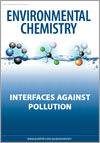
Environmental Chemistry
Volume 14 Number 5 2017
Interfaces Against Pollution
EN16192Doped Ti-pillared clays as effective adsorbents – Application to methylene blue and trimethoprim removal
Environmental context. Water is an essential compound for life; however, several factors limit the amount available for human consumption. Every day, thousands of pollutants are discharged into drinking water. Here, new materials that are efficient as adsorbents and photocatalysts for pollutants are reported.
EN16210Geometrical properties of materials for energy production by salinity exchange
Environmental context. Oceans and seas have the potential to play a significant role in providing renewable and clean energy. In particular, salinity difference energy aims to extract the enormous amount of energy that is released when fresh water rivers flow into the oceans. Capmix methods are focused on this challenge by using capacitive carbon electrodes whose optimisation will certainly help in developing salinity difference energy.
EN17004Desorption rate of glyphosate from goethite as affected by different entering ligands: hints on the desorption mechanism
Environmental context. Glyphosate is a heavily used herbicide that is mobilised in soil and sediments through adsorption–desorption processes from the surface of mineral particles. We demonstrate that the desorption rate of glyphosate from goethite, a ubiquitous mineral, is nearly independent of the concentration and nature of the substance that is used to desorb it. The results elucidate the desorption mechanism and are relevant to understand and predict the environmental mobility of glyphosate.
EN16216The relationship between inner surface potential and electrokinetic potential from an experimental and theoretical point of view
Environmental context. Interfacial properties of colloid and nanoparticles are directly related to the reactivity and surface densities of existing surface sites. Surface characterisation of particles provides only some kind of average surface properties. Analysis of well-defined monocrystal surfaces, which form the surface of the single particle, leads to a better understanding of surface reactions and mutual interactions of adjacent crystal planes on average surface properties.
EN17028Metal removal by pine bark compost using a permeable reactive barrier device at laboratory scale
Environmental context. Permeable reactive barriers are a developing technology to clean up contaminated groundwater. The contaminant plume moves through a reactive material placed below ground that retains or degrades the pollutants. This study shows that pine bark compost strongly adsorbs and retains metals, mostly by interaction with the organic matter of the compost, and thereby serves as a suitable reactive filler material to clean up contaminated groundwater.
EN16213Assessing the optimal conditions for surface-mediated disinfection of Influenza A virus solutions
Environmental context. Transmission of viruses is related to their survival while being outside the host body. By means of experimental and computational simulations we assess the optimal conditions for virus deactivation upon contact with particularly functionalised substrates. These results constitute the basis for the design of new surfaces with high antiviral activity that can be important in public or sensitive environments such as in hospitals where the contamination and spreading of viruses are a critical issue.
EN17102Adsorptive removal of ammonium ion from aqueous solution using surfactant-modified alumina
Environmental context. Ammonium ion, an inorganic pollutant in agricultural land, can induce eutrophication, impacting on water quality. We investigate the adsorption of ammonium ion on surfactant-modified alumina and demonstrate highly efficient removal of ammonium ions by the alumina from two agricultural water samples. Adsorption mechanisms are also proposed based on adsorption isotherms, surface modification and the change in surface charge.
EN17003Foam placement for soil remediation
Environmental context. Soil pollution is an important concern and remediation techniques, especially in situ techniques, should be studied. We investigate a new technique based on foam generation and placement inside the porous soil to improve the pollutant extraction. This technique could be useful when the soils are heterogeneous because it allows a complete soil sweeping.



